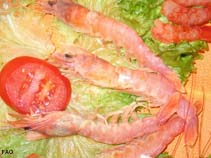Haliporoides triarthrus Stebbing, 1914
Knife shrimp| Native range | All suitable habitat | Point map | Year 2050 |

|
| This map was computer-generated and has not yet been reviewed. |
| Haliporoides triarthrus AquaMaps Data sources: GBIF OBIS |
Classification / Names Common names | Synonyms | CoL | ITIS | WoRMS
Malacostraca | Decapoda | Solenoceridae
Environment: milieu / climate zone / depth range / distribution range Ecology
Benthic; depth range 180 - 800 m (Ref. 106893). Tropical, preferred 21°C (Ref. 107945); 3°S - 36°S, 17°E - 48°E
Distribution Countries | FAO areas | Ecosystems | Occurrences | Introductions
Southeast Atlantic and Western Indian Ocean: from Kenya and Madagascar to Cape of Good Hope, South Africa.
Length at first maturity / Size / Weight / Age
Maturity: Lm ?, range 3 - 5 cm Max length : 15.3 cm TL male/unsexed; (Ref. 249); max. reported age: 3.00 years (Ref. 106893)
Deep sea. Lives in soft substrates composed of sticky mud with foraminiferous remains near the edge of continental shelf (Ref. 106893).
Life cycle and mating behavior Maturity | Reproduction | Spawning | Eggs | Fecundity | Larvae
Members of the order Decapoda are mostly gonochoric. Mating behavior: Precopulatory courtship ritual is common (through olfactory and tactile cues); usually indirect sperm transfer.
Main reference
References | Coordinator | Collaborators
Holthuis, L.B. 1980. (Ref. 8)
IUCN Red List Status (Ref. 130435)
CITES status (Ref. 108899)
Not Evaluated
CMS (Ref. 116361)
Not Evaluated
Threat to humans
Human uses
Fisheries: highly commercial
FAO - Fisheries: landings | FishSource | Sea Around Us
Tools
More information
Internet sources
BHL | BOLD Systems | CISTI | DiscoverLife | FAO(Fisheries: ; publication : search) | Fishipedia | GenBank (genome, nucleotide) | GloBI | Gomexsi | Google Books | Google Scholar | Google | PubMed | Tree of Life | Wikipedia (Go, Search) | Zoological Record
Estimates based on models
Preferred temperature
(Ref. 115969): 10 - 15.7, mean 12.9 (based on 38 cells).
Resilience
(Ref. 69278):
High, minimum population doubling time less than 15 months (K=0.3-1.3; tmax=3).
Nutrients: Calcium = 109 [35, 184] mg/100g; Iron = 1.59 [1.21, 1.97] mg/100g; Protein = 20.2 [19.2, 21.3] %; Omega3 = 0.285 [0.185, 0.386] g/100g; Selenium = 48.3 [-31.7, 128.3] μg/100g; VitaminA = 0 μg/100g; Zinc = 1.79 [1.17, 2.40] mg/100g (wet weight).



